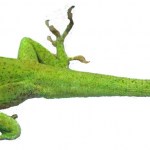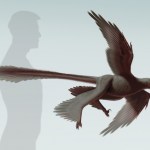tail
A reader sent me the following question:
"How does a lizard grow a new tail?"
This was a very timely question as new research has shed light on this very phenomenon. A team of experts at Arizona State University led by Dr. Kenro Kusumi and colleagues have been studying limb regeneration in lizards.
Green anole lizard (Anolis carolinensis) with tail a new tail (image credit: Hutchins et al./PLoS ONE)
The green anole lizard (pictured above) can lose its tail when captured by a predator. They are then able to regrow their tails, although they do not look quite like the original. Dr.…
This newly discovered feathered dinosaur, Changyuraptor yangi, was built like a modern airplane. Illustration by S. ABRAMOWICZ, DINOSAUR INSTITUTE, NHM.
Photo of fossil by: Luis Chiappe Dinosaur Institute, NHM as published in the USA Today
The discovery of this non-avian dinosaur, Changyuraptor yangi, that lived 125 million years ago suggests that flight came before birds. The fossil was discovered in the Liaoning Province of northeastern China by Luis Chiappe from the Natural History Museum in Los Angeles, CA. At nearly 4 feet long, it is the largest so-…
Dogs, like people, are susceptible to a form of obsessive compulsive disorder (OCD) known as canine compulsive disorder (CCD). In fact, the news story at the end of this blog describes CCD and also discusses a form of OCD in Siamese and Persian cats that is related to stress.
A prior study suggested that dogs are good models for OCD in humans since their physiology is similar and they share the same environment as humans. Dr. Hannes Lohi (University of Helsinki) and colleagues found that dogs who received vitamin and mineral supplements were less likely to exhibit CCD (measured as excessive…
The tail of a thresher shark (Alopias vulpinus). From Wikipedia.
Thanks to sensational documentaries and summer blockbusters, we are all familiar with the anatomy of a shark attack. The victim, unaware that they are in peril, is struck from below and behind with such speed and violence that, if they are not actually killed during the first strike, they soon find themselves a few pounds lighter in the middle of a billowing red cloud. The trouble is that this stereotyped scenario does not hold for all sharks, particularly one peculiar group of deepwater sharks which has long puzzled…
When danger threatens many lizards can detach their tails, leaving them behind as decoys in the hope that the predator will attack it rather than the lizard itself. But the tail doesn't just lie there as bait. For half an hour after they've been severed, the disembodied tails perform a complex dance, flipping, lunging and jumping up to an inch in the air. These acrobatics serve to distract the predator even further.
For the first time, Timothy Higham and Anthony Russell have studied the movements of severed gecko tails to understand how they can move in such complex ways without any input…
When sportsmen use rackets or bats, their best bet is to hit a ball on the "sweet spot", the point where various forces balance out to deliver powerful blows with only very small forces on the wielder's wrist. Engineers have the right tools and models to work out where this spot lies on their instruments. Now, palaeontologists have used the same techniques to study biological hammers that adorn the tails of giant prehistoric armadillos called glyptodonts.
At first glance, glyptodonts have little in common with the likes of Andy Murray and Roger Federer. These armoured beasts lived in the…
It seems like an uneven match. In one corner, the unassuming California ground squirrel (Spermophilus beechyi), 30cm in length. In the other, the northern Pacific rattlesnake (Crotalus oreganos), more than twice the length of the squirrel, and armed with hinged fangs that pack a lethal venom. But thanks to a cunning adaptation, the squirrel often gets an unexpected upper hand in this bout.
Ground squirrels live in a series of burrows that keep them out of reach of most predators. Snakes, however, have exactly the right body plan for infiltrating long sinuous tunnels, and it's not surprising…
Geckos are nature's champion climbers. With remarkable ease, they can scamper across ceilings and up smooth vertical surfaces, and they do so at speed. A vertically running gecko can cover 15 times the length of its body in a single second. So far, scientists have focused their attention on the gecko's amazingly adhesive feet but a new study demonstrates the importance of a neglected piece of their climbing gear - their tails. Geckos use their tails to stop themselves from falling, and to land safely if they do.
A gecko's foot is a marvel of biological engineering. Rather than relying on…
Everybody thinks a wagging tail is the sign of a happy dog. But researchers have recently made a telling discovery: a) not all tail wagging is necessarily positive and b) one can tell this by which side (left or right) the tail wags on!Happy dog, Carnivorous Slobbius
According to a new study--,AeuAsymmetric Tail-wagging Responses by Dogs to Different Emotive Stimuli,,Aeu by Giorgio Vallortigara of the University of Trieste in Italy and Angelo Quaranta and Marcello Siniscalchi of the University of Bari, Italy--positive feelings are displayed by wagging on the right side, while more negative…

